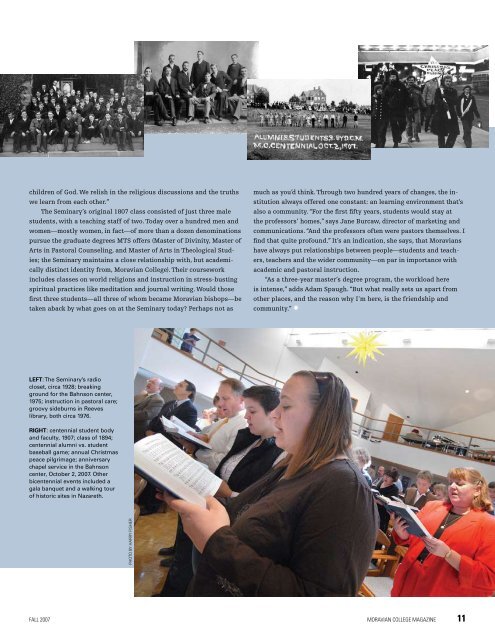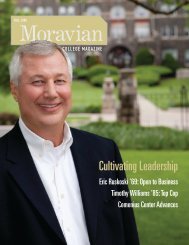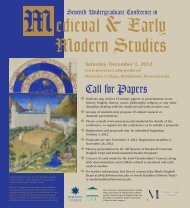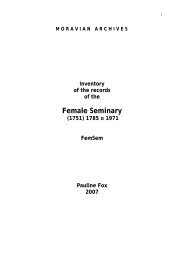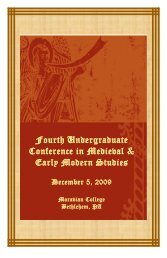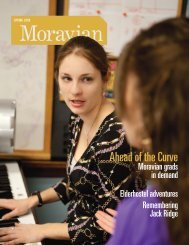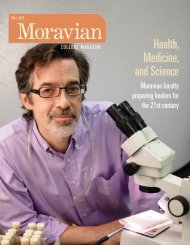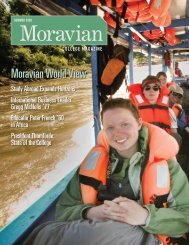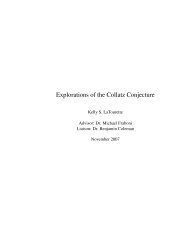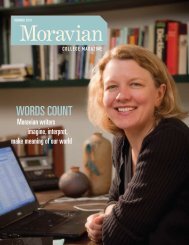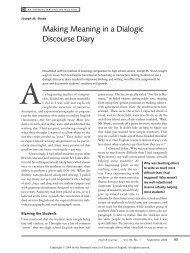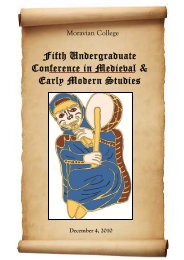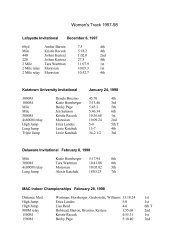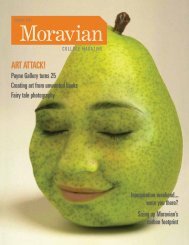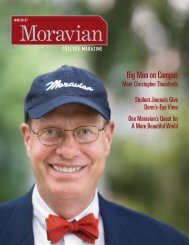Family Farms - Moravian College
Family Farms - Moravian College
Family Farms - Moravian College
You also want an ePaper? Increase the reach of your titles
YUMPU automatically turns print PDFs into web optimized ePapers that Google loves.
children of God. We relish in the religious discussions and the truths<br />
we learn from each other.”<br />
The Seminary’s original 1807 class consisted of just three male<br />
students, with a teaching staff of two. Today over a hundred men and<br />
women—mostly women, in fact—of more than a dozen denominations<br />
pursue the graduate degrees MTS offers (Master of Divinity, Master of<br />
Arts in Pastoral Counseling, and Master of Arts in Theological Studies;<br />
the Seminary maintains a close relationship with, but academically<br />
distinct identity from, <strong>Moravian</strong> <strong>College</strong>). Their coursework<br />
includes classes on world religions and instruction in stress-busting<br />
spiritual practices like meditation and journal writing. Would those<br />
first three students—all three of whom became <strong>Moravian</strong> bishops—be<br />
taken aback by what goes on at the Seminary today? Perhaps not as<br />
LeFT: The Seminary’s radio<br />
closet, circa 1928; breaking<br />
ground for the Bahnson center,<br />
1975; instruction in pastoral care;<br />
groovy sideburns in Reeves<br />
library, both circa 1976.<br />
RighT: centennial student body<br />
and faculty, 1907; class of 1894;<br />
centennial alumni vs. student<br />
baseball game; annual Christmas<br />
peace pilgrimage; anniversary<br />
chapel service in the Bahnson<br />
center, October 2, 2007. Other<br />
bicentennial events included a<br />
gala banquet and a walking tour<br />
of historic sites in Nazareth.<br />
photo by harry fisher<br />
much as you’d think. Through two hundred years of changes, the institution<br />
always offered one constant: an learning environment that’s<br />
also a community. “For the first fifty years, students would stay at<br />
the professors’ homes,” says Jane Burcaw, director of marketing and<br />
communications. “And the professors often were pastors themselves. I<br />
find that quite profound.” It’s an indication, she says, that <strong>Moravian</strong>s<br />
have always put relationships between people—students and teachers,<br />
teachers and the wider community—on par in importance with<br />
academic and pastoral instruction.<br />
“As a three-year master’s degree program, the workload here<br />
is intense,” adds Adam Spaugh. “But what really sets us apart from<br />
other places, and the reason why I'm here, is the friendship and<br />
community.” W<br />
FALL 2007 MORAVIAN COLLEGE MAGAZINE 11


